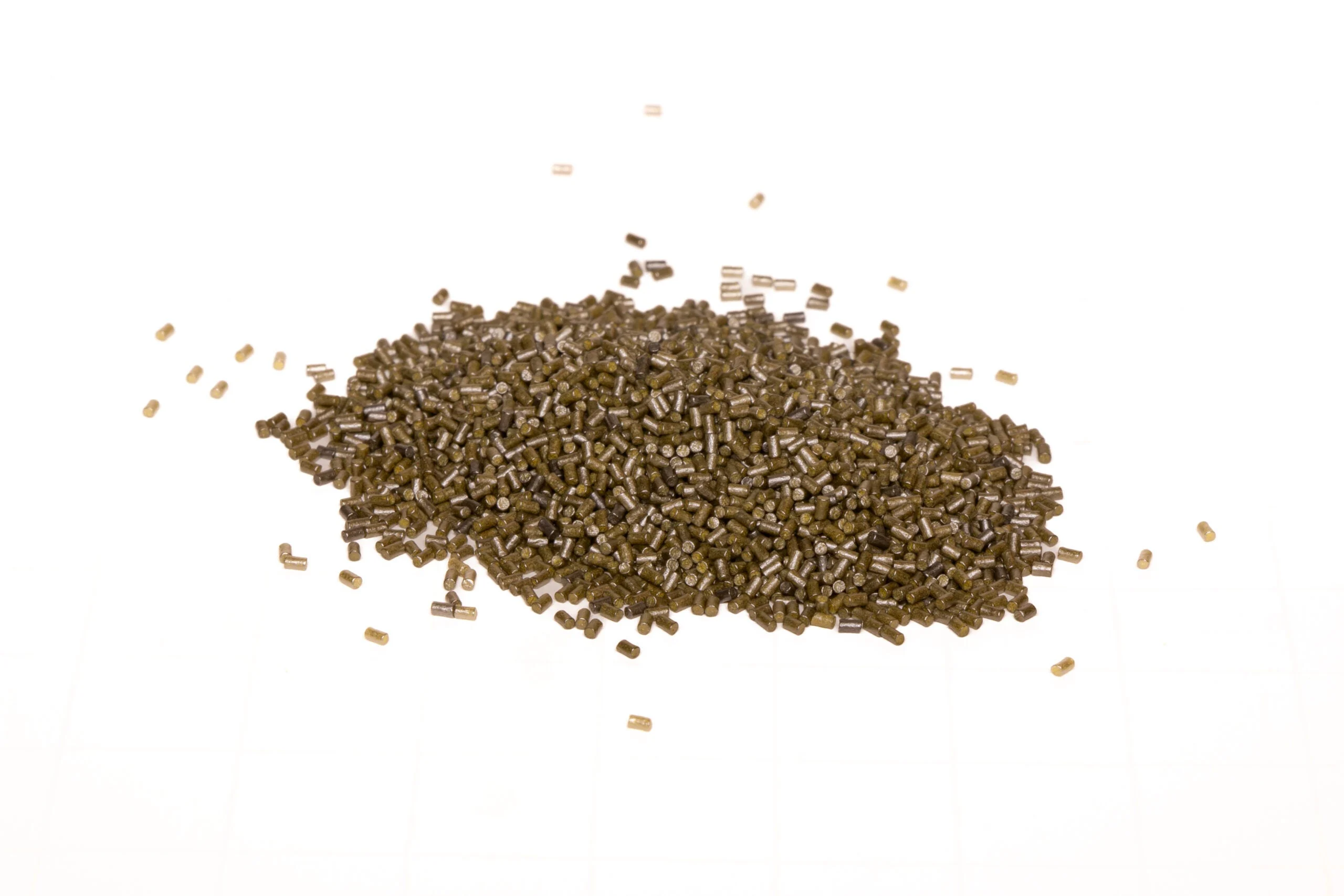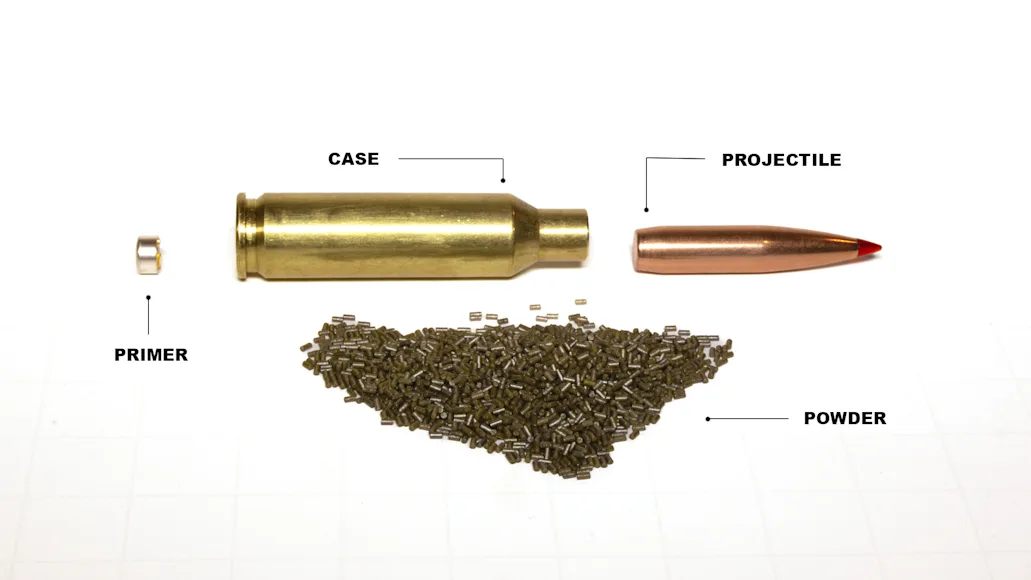We may earn revenue from the products available on this page and participate in affiliate programs. Learn more ›
If you’re wondering, What are the basic parts of ammunition? then you have come to the right place. Let us break it down for you. The four fundamental components of all types of ammo are the case, the primer, the powder, and the projectile. When assembled together, they make up a rifle or pistol cartridge or a shotgun shell. All are examples of self-contained ammunition, which has been with us for well over a century. Using these four parts, ammunition is either made by factories or handloaders, and though the make-up and design of the basic parts have evolved and continue to do so, their overall function and how they work together have not. Here’s a full breakdown of the basic parts of ammunition.
Basic Part of Ammunition #1: The Case

The cartridge case is what holds all self-contained ammunition together. With rifle and handgun ammunition, the case is sometimes referred to as “brass.” With shotguns, the case is most often called a shell or a hull. Regardless of what you call it, the case will hold the finished load’s primer or priming compound, the gunpowder, and the bullet or projectile(s).
Most rifle and handgun cartridge cases are made of brass or steel. Brass cases are reloadable, while steel cases are not. With shotgun hulls or shells, the base is made of brass for strength, and the rest of the case is made of plastic for economy. Shot shells are also reloadable. True Velocity is now making rifle cases out plastics and metal, similar to shot shells. With the exception of rimfire ammunition, you’ll find information about the firearm the cartridge or shell is intended for impressed on the case head. With most shotgun shells, additional information about the load is printed on the plastic portion of the hull.
Basic Part #2: The Primer

There are two types of priming methods used in modern, self-contained ammunition. With rimfire ammunition, the priming compound is distributed in the hollow rim at the base of the case—hence the name “rimfire.” The priming compound is shock sensitive, so when the rim is compressed by the firing pin, the compound ignites and starts the gunpowder burning. Rimfire cases are not reloadable. The centerfire primer works similarly, but inside the primer is a metal anvil that helps to ignite the priming compound. Because the primer is a separate/replaceable part, centerfire ammunition is reloadable. Centerfire primers for rifle, handgun, and shotgun ammunition come in various sizes and deliver different levels of intensity, based on the cartridge/shell they’re intended for and the propellant they’ll be paired with.
Basic Part #3: The Powder (or Propellent)

Early self-contained ammunition was loaded with blackpowder—the original gunpowder. Blackpowder is made from potassium nitrate, charcoal, and sulfur. The speed at which blackpowder burns is controlled by the size of the granules, and blackpowder burns very consistently. However, it is also very dirty.
Modern ammunition is fueled by smokeless gunpowder, which burns much cleaner. It varies in granule shape and size too, but it’s made from nitrocellulose and nitroglycerin, and the burn rate is primarily controlled by chemical make-up. Modern smokeless gunpowders also contain stabilizers to prevent or slow self-decomposition, as well as de-coppering agents to limit barrel fouling. Typically, the larger the powder charge or the case capacity of the cartridge, the slower the burn rate of the gunpowder to be used. For example, 22 Long Rifle ammunition uses very fast burning gunpowders and the much larger 338 Winchester Magnum uses slower burning gunpowders.
Basic Part of Ammunition #4: The Projectile

Because ammunition is used for a lot of different things, like target shooting, hunting, and self-defense, projectiles vary. Bullets are mostly made of copper and lead or copper and lead alloys, and shot shells are generally filled with lead, steel, tungsten, and even bismuth pellets. Shotshells can also be loaded with slugs, and as with bullets, these slugs are usually made of some form of copper or lead. However, with shotshells—even those loaded with slugs—you’ll also find plastic wadding or fillers to help compartmentalize the shot charge and to take up space inside the shell. Some cartridges and shotgun shells also utilize a polymer, projectile-encasing sabot that allows for a smaller caliber projectile to be fired in a larger caliber barrel.

How Ammunition Works
Ammunition projectiles are driven out of the barrel and toward the target by pressure. When the firing pin strikes the primer, a spark is created that causes the gunpowder inside the cartridge case or shell to burn. The burning gunpowder creates gas and pressure. This pressure, which is contained by the firearm, forces the bullet out of the barrel and toward your target. The more pressure that’s produced, the faster the bullet moves. Ammunition and firearms are designed to withstand certain amounts of pressure, and semi-automatic firearms utilize a small portion of this pressure to cycle the action. Shooters select different firearms and ammunition based on the design, diameter, weight, and the speed of the bullet they need for different shooting applications.
Related: Best Long-Range Hunting Cartridges
A Few Words on Safety and SAAMI

Always make sure you load the correct ammunition in your firearm. Centerfire ammunition cartridges and shells are marked, but with rimfire ammunition you must rely on visual recognition or the box the ammunition comes in. Using the wrong ammunition can jam or damage your firearm. It can even turn a gun into sort of a pipe bomb and seriously injure you. You should also always check cartridges and shells for damage or miss-assembly. Though very rare, you’ll find factory ammunition without primers, with primers inserted upside down, and even with missing or miss-loaded bullets. Also, never use handloaded ammunition you did not create. You never know how some fool might have incorrectly assembled the basic parts of ammunition.
Factory loaded ammunition is almost always very well assembled and very safe. This is primarily due to the Sporting Arms and Ammunition Manufacturer’s Institute (SAAMI). SAAMI was established in 1926, partly to create and maintain ammunition standards. Not only do SAAMI standards stipulate the particulars of each part of ammunition, but they’ve also established the pressure limits that make factory and even properly handloaded ammunition so safe to shoot. SAAMI is the reason 30-30 Winchester ammunition made in 2023 will fit, function, and safely fire, in a 30-30 Winchester rifle made more than 100 years ago.






